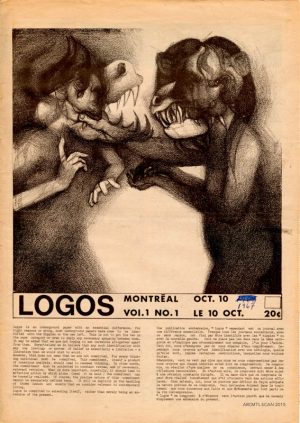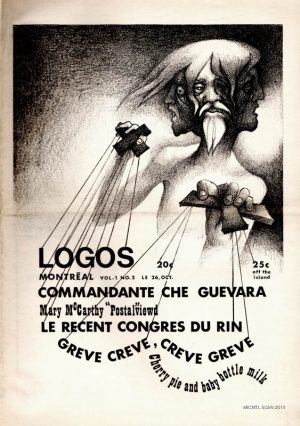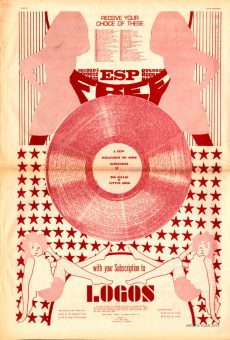LOGOS and Montreal counter-culture
LOGOS and Montreal counter-culture
When one considers the earliest days of Montreal’s counter-culture and underground arts and activist scenes, it’s hard to exaggerate the importance and influence of LOGOS magazine. It was our city’s own contribution to the independent press that was emerging across North America, such as the Village Voice and the Georgia Straight. This entirely new publishing milieu gave a voice to the mid 1960s generation of youth that did not hear any of their political or aesthetic preoccupations reflected in the dull, conservative mainstream media landscape of the time.
ARCMTL, the non-profit archive of local independent culture behind this Montreal Underground Origins project, considers its set of Logos magazines as part of the very foundation of its collections of Montreal underground culture. Shortly after it was founded in 1998, Archive Montreal discovered stacks of old Logos magazines in the back rooms of Montreal’s oldest used bookstore, Russelll’s on St. Antoine St., just before it was demolished to make way for the expanded Palais des Congrès. Nestled among stacks of old Montreal newspapers from the 1800s and 1900s, such as the Witness, Star and World Wide, the psychedelic art adorning the Logos covers stood out as a complete break with all that came before it. Since then, it has emerged that just about every other alternative, underground or counter-culture publication that followed Logos in Montreal and Quebec was inspired and influenced by it.
We sat with founding editor Paul Kirby and his partner Adriana Kelder at Archive Montreal’s archive centre in the fall of 2015 to look at old issues with them, talk about how Logos came about and what their experience living in Montreal in that era was like. What follows is an edited version of the conversation, interpolating a transcript of Kirby’s presentation at the October 2015 conference, Contre-Culture: Existences et persistence’s at McGill University, as well as portions of a phone interview with Kirby conducted by our colleagues at Ghetto Mohawk in December 2014 for their special issue devoted to Logos, available to order on their website.
LR= Louis Rastelli
AK= Adriana Kelder
PK= Paul Kirby
AT = Alex Taylor
LR: How did you come to be in Montreal in 1966?
AK: I went to school in the Lakeshore, in Beaconsfield. I was born in Holland; my parents emigrated when I was 8 and came to Montreal in 1956. I was going to the Beaux-Arts when I met Paul through my oldest brother Robert Kelder, who wrote for Logos. I was fresh out of high school when I started at the Beaux-Arts, I think I was 19. It was like a four-year college course that I never finished before we left town.
LR: And how about you, Paul?
PK: I arrived in Montreal around ’66. I had gone from the University of British Columbia to North Africa and then back to Vancouver, before enrolling in graduate work in psychology at McGill. I got so disillusioned by the narrow focus of McGill psychology that I ended up becoming good friends with the head of the Philosophy department, having already gotten a degree in philosophy. Another friend was Chandra Prakash, a graduate student in English Literature (later on a longtime film teacher at Vanier College), was very involved as well against the Vietnam war, Palestinian rights and human rights activities in Montreal. We made some proposals to the Liberal government, even met a couple of ministers regarding Canada’s position on Vietnam. We discovered that they were saying one thing in public, but then backing away from any kind of commitment. In the process, we connected with Laurier Lapierre, a journalist at the CBC, hosting the program “This hour has seven days”. It was one of the best television news shows, a fellow Master’s student John Grey was a correspondent—he may have been involved in that radical McGill Student Handbook. The show was taken off the air because it was considered too radical. Anyway, the head of the philosophy department at McGill and myself who brought Noam Chomsky to McGill- he came and talked to the combined psychology and philosophy department.
The speech itself was such an incredibly beautiful academic shredding of 30 years of McGill’s deterministic behavioralism, and very pointedly, the experiments at the Allan [MEMORIAL] with the CIA. It was a beautiful thing to watch.
We had a number of meetings with Chomsky privately, telling him of our plans to gather a bunch of intellectuals and artists and writers, and go and work in the fields of North Vietnam. He immediately pointed out to me would be a Godsend to the U.S. forces, because they would just drop a few bombs and kill all the people that were opposed to the Vietnam war. He suggested we start a hostel for draft-dodgers and war-resisters in Montreal instead, which is what we did. It was called the Gandhi House, down on St-Antoine at Atwater, we set it up in conjunction with a man by the name of Nardo Castillo.
He was one of the key people in the Spanish anarchist world, involved in the Spanish Club and most likely the child of some Spanish civil war anarchist.
The draft dodgers were actually quite a small community and, you know, it was difficult at the time to find any English-speaking Montrealers that were against the war. Over the period of like six months there was probably around 100 people that came to Montreal as war resisters. A lot of them were artists, photographers, graphic designers, and writers who, for various reasons, were coming up to Canada to resist the war or to escape the clutches of the draft system. These became the nucleus of the people that eventually became the Logos community.
We all realized that we had this incredible pool of talent and at that time, we really wanted to start something that would ignite everything we had, and that was Logos.
Logos went through quite a few changes, but in the beginning we really believed in the principles of participatory democracy, and how things could change if people were just rational. We were young idealists. At the time Lester Pearson had realized that Quebec was a bubbling pot of potential uprising so he got a hold of three or four Quebec intellectuals, one of them being Trudeau, another was Marchand and Chretien and Lapierre…
AK: And René Levesque too.
PK: Yeah! Pearson was a very smart guy and he really wanted to co-opt the Quebecois movement. Marchand was the newly appointed, freshly-minted minister and he made a speech somewhere in Canada—a very anti-American speech—on how Canada had to pull out of any involvement with the US fight in Vietnam. So Chandra and I said: “Fantastic! Meet us for lunch and we’ll work with you on this! You’ve got two graduate students here and we’ll just go-to-town with you.”
We did meet him for lunch, and it was the most amazing 180 degree turn. He had gotten blasted after his speech by Pearson and a few others hardcore Liberals. They said “You can’t go near those ideas. We don’t want to turn on our brothers down south.” So Chandra and I were just aghast. It was another one of those pivots where our naivety did another turn and the wheel turned a bit more. It was one of the other reasons for getting the paper together, because we knew that in Canada, there was no source of political, anarchist fervour anywhere. The other papers were more oriented around drugs and music, we got involved in music and psychedelia and things like that but were always pushing the political agenda as much as we could. Hence, the chasing of us by the heavy hand of the man!
I was still living in Gandhi House when we started the paper. It was huge, two floors of a really old cockroach-infested house on St-Antoine.
AK: It was ghetto.
PK: The area was starting to be inhabited by artists and writers who were being pushed up the hill, pushed down below. I found out about the place from a sculptor who lived right opposite the street. It was big, and we could put up a lot of people, it had a huge kitchen. The draft dodgers and resisters didn’t stay very long, a lot of them moved into I guess what is Mile-End now. It was cheap as hell. We stayed there until we moved to Coloniale Street.
LR: Did someone keep it going after you moved out?
PK: I’d have to say, I don’t think so. Chandra wasn’t involved with Gandhi house very much, but it’s in the number one issue of Logos…
It was the beginning, at the times, of underground press. There was the Berkeley Barb, The Village Voice, The LA Free Press, and few others. We formed a committee of five people, among them Chandra, Adriana’s brother Robert, John Wagner and Alan Shapiro, and put out a first edition in the fall of 1967. John was our cover artist and made four or five covers through that early period; he eventually went to Arizona to concentrate on his art. Chandra also got less involved, since he had his PhD going. In the meanwhile, I had quit McGill, so the newspaper fell to Robert and myself.
Just after the first issue, we acquired a loft on 3666 Saint-Laurent, above a bakery. I think we put out three or four issues out of that loft, and then we rented a duplex on the corner of Coloniale and Prince Arthur, right beside a fish market. We had the office in the basement, and living quarters on the other floors. That was the first time we all moved together, so it became known as the Logos house.
AT: (flipping through the first issue of Logos) There’s a Le Chateau ad in there.
PK: It funny that you mention that ad. I spent two or three days, if not weeks, just walking around Montreal, going into places saying: “We’re starting an underground newspaper or a magazine dealing with the arts and politics, would you like to advertise in it?” And lo and behold, at Le Chateau, which was just the one store on Ste-Catherine Street, I saw this beautiful jacket in their window, and I ended up getting it in exchange for an ad.
There’s an ad for a magazine called Take One. I walked into their office, they had just started, and I walked in there not knowing what the hell it was about and pitched the guy. He had this very peculiar smile on his face and finally said: “D’you know what we do?” and I said: “Not really, but I’d love to have you advertise in our paper.” And he smiled and said: “OK, I’ll do it!”
And he wrote a cheque for fifty bucks or something. It was a film magazine.
None of us had any grand designs. We sold the paper, and we sold the ads, but we never had any belief that the paper would become a commercial, long-running success.
LR: Did you break even in the beginning or at least cover costs?
PK: Our printing costs were so minimal.
LR: Some of these businesses in the ads you probably knew about already, the New Penelope for example, and others you were saying from just walking around.
PK: I might have met the guy from the New Penelope [GARY EISENKRAFT] while putting that first issue together. We actually started a free university together through the paper and I don’t know what happened with that.
LR: Was Café Prag a place you would hang out at?
PK: Café Prag was where you [ADRIANA] and I used to go to dinner, with the vanilla pudding.
AK: (laughs) [LOOKING AT ISSUE] This is somebody we never knew what happened to him, Allan Shapiro. He was an American. He went to Paris and got involved in the student revolt…
PK: In ’68. He phoned us from the US embassy and he was in Prague and Berlin and then we lost track of him… it was either the second or third issue.
LR: How many people were in the Logos crew then?
PK: At that point, if you took the whole sort of family, there was probably like 20-25, and we always told people: “Take the paper and try to sell it and if you can return some money, fine,” but it was never our intent to make money. I don’t know how in the hell we fed ourselves.
AT: Did advertising cover the printing of the paper?
PK: It must have because there was a printer –the same printer throughout the whole run…
LR: Was it the same printer as this Midnight magazine, by chance? The format and paper type is pretty much identical.
AK: Some of the people that wrote for us also worked at Midnight.
PK: One was from England, and there was one other guy that published all those newspapers, there was about 8 of them, I think. He had one office, and each paper had one desk and one person, and that’s all they did was banged them out!
LR: The graphics that you would get, they were quite interesting and very nice. Did they have to draw them that size and bring you the originals?
PK: We always worked on 20% reduction. We would do all the original artwork, paste it all up—spent a stupid amount of time justifying all of those columns—and we had these IBM Selectric typewriters. We had one person who was like the design/ layout and he or she and myself did the layout, then we took all the pages to the printer and he just photographed them and burnt the plates and ran the paper.
LR: Did you do 10 000 copies or so?





Thanks for this interview!
I´m from Finland and used to be part of the Finnish underground movement late 60s. Believe it or not I happen to have Logos vol 1, no 10 and vol 2, nos 1-4. I don´t need them anymore. Are you still interested to have Logos issues?
Great web site!